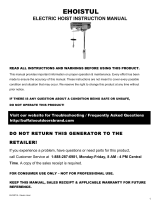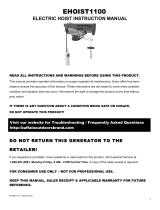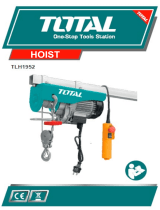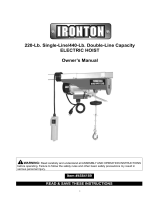Page is loading ...

User Manual
V 3.04 8041840, 8041857, 8107674
Please read and understand all instructions before use. Retain this manual for future reference.
Electric Cable Hoist

2 For technical questions call: 1-800-665-8685
V 3.04 8041840, 8041857, 8107674
Electric Cable Hoist
SPECIFICATIONS
SKU 8041840 8041857 8107674
Title 220 / 440 lb Electric
Cable Hoist
440 / 880 lb Electric
Cable Hoist
660 / 1,320 lb Electric
Cable Hoist
Type Electric Cable Electric Cable Electric Cable
Lift Capacity 220 lb single line,
440 lb double line
440 lb single line,
880 lb double line
660 lb single line,
1,320 lb double line
Cable Length 40 feet 40 feet 40 feet
Lifting Height 38 ft single line,
19 ft double line
38 ft single line, 19 ft
double line
38 ft single line, 19 ft
double line
Lifting Speed 33 FPM single line,
16 FPM double line
33 FPM single line,
16 FPM double line
33 FPM single line,
16 FPM double line
Voltage Rating 120 volts AC 120 volts AC 120 volts AC
Corded Remote 5-1/2 ft 5-1/2 ft 5-1/2 ft
Power Power up and down Power up and down Power up and down
Contents Pulley block to
increase capacity
Pulley block to
increase capacity
Pulley block to
increase capacity
INTRODUCTION
Perfect for engine repair or loading and unloading heavy items from trucks and trailers.
IMPORTANT SAFETY PRECAUTIONS
WARNING! Read and understand all instructions before using this tool. The operator must follow
basic precautions to reduce the risk of personal injury and / or damage to the equipment. Before
allowing someone else to use this tool, make sure they are aware of all safety information.
WARNING! The warnings, cautions and instructions discussed in this instruction manual cannot
cover all possible conditions and situations that may occur. Common sense and caution are factors
that cannot be built into this product, but must be supplied by the operator.

Visit www.princessauto.com for more information 3
8041840, 8041857, 8107674 V 3.04
Electric Cable Hoist
NOTE: Keep this manual for the safety warnings, precautions and operating, inspection and
maintenance instructions. When this manual refers to a part number, it refers to the included parts list.
WORK AREA
1. Operate in a safe work environment. Keep your work area clean and well lit. Do not expose
the tool to rain or any other kind of bad weather. Do not use in damp or wet locations.
2. Keep anyone not wearing the appropriate safety equipment away from the work area.
NOTE: Minimize distractions in the work environment. Distractions can cause you to lose
control of the tool.
3. Store tools properly in a safe and dry location to prevent rust or damage.
4. Always lock up tools and keep them out of the reach of children.
PERSONAL SAFETY
CAUTION! Wear protective equipment approved by the Canadian Standards Association (CSA) or
American National Standards Institute (ANSI) when using the tool.
1. Dress properly, wear protective equipment. Use breathing, ear, eye, face, foot, hand and head
protection. Always wear ANSI approved impact safety goggles, which must provide both
frontal and side protection. Protect your hands with suitable gloves. Wear a full-face shield
if your work creates metal filings or wood chips. Protect your head from falling objects by
wearing a hard hat. Wear an ANSI approved dust mask or respirator when working around
metal, wood and chemical dusts and mists. Wear ANSI approved earplugs. Protective,
electrically non-conductive clothes and non-skid footwear are recommended when working.
Wear steel-toed boots to prevent injury from falling objects.
2. Control the tool, personal movement and the work environment to avoid personal injury or
damage to the tool. Stay alert, watch what you are doing and use your common sense.
a. Keep articles of clothing, jewelry, hair, etc., away from moving parts to avoid
entanglement with a tool.
b. Do not operate any machine / tool when tired or under the influence of drugs, alcohol
or medications.
c. Do not overreach when operating a tool. Proper footing and balance enables better
control of a tool in unexpected situations.
SPECIFIC SAFETY RECAUTIONS
1. Do not exceed the maximum capacity of the hoist. Overloading can cause damage to the tool,
failure of the tool, personal injury or death.
2. Assure that the mount to which the hoist is attached will hold the weight you will apply using
the hoist.
3. All users must understand the operation of all controls and learn how to stop the hoist
quickly in case of emergency.
4. Do not use inappropriate attachments to extend the length of the cable.
5. Never lift people or hoist loads over people.
6. Use a spotter to assist you in assuring that it is safe to operate the hoist.
7. Never operate the hoist if the cable shows any signs of weakening, is knotted or kinked.

4 For technical questions call: 1-800-665-8685
V 3.04 8041840, 8041857, 8107674
Electric Cable Hoist
8. Observe the spooling of the cable onto the drum. Side pulls can cause the cable to pileup at
one end of the drum. To correct uneven stacking, spool out that section of cable and move
it to the other end of the drum and continue hoisting. Uneven spooling causing cable pileup
can interfere with the tie rods causing damage to the hoist.
10. Never connect the hook back to the cable. This causes cable damage. Always use a sling or
chain of suitable strength.
11. Use heavy-duty work gloves when handling the cable.
12. Wear safety glasses when working.
13. All moving parts should always be kept well lubricated. Before operation, check that the
various parts have no damage and idle motion is in good condition.
14. Use only attachments and / or adapters supplied by the manufacturer.
15. Maintain the tool in good condition. Keep it clean for the best and safest performance.
16. Before lowering load, ensure that there are no obstructions underneath and that all people
are standing clear. Stay out of the direct line that the cable is pulling. If it slips or breaks, it
will “whiplash” along this line.
17. Do not allow untrained persons to operate the tool.
18. Make sure there is enough clearance around the tool and the load for the movement.
19. Do not place your hands between the moving components.
20. Do not hold the cable while using the hoist, as your hand may become caught.
21. Only use with accessories rated to handle the forces exerted by this tool during operation.
Other accessories not designed for the forces generated may break and forcefully
launch pieces.
22. Inspect the tool before each use. DO NOT use if bent, broken, cracked, leaking, otherwise
damaged, if any suspect parts are noticed or it has been subjected to a shock load.
23. Check to ensure that all applicable bolts and nuts are firmly tightened.
24. If the tool needs repairing or any parts need to be replaced, have it repaired by an authorized
service technician. Use only manufacturers recommended replacement parts.
ELECTRICAL SAFETY
1. Disconnect power supply. Disconnect the tool from the power supply when not in use, before
cleaning, servicing or changing any parts.
2. Protect yourself against electric shocks when working on electrical equipment. Avoid body
contact with grounded surfaces such as pipes, radiators, cooking stoves and refrigerators.
There is an increased chance of electrical shock if your body is grounded.
3. Double insulated tools are equipped with a polarized plug (one blade is wider than the other.)
This plug will fit in a polarized outlet only one way. If the plug does not fit fully in the outlet,
reverse the plug. If it still does not fit, contact a qualified electrician to install a polarized
outlet. Do not change the plug in any way. Double insulation eliminates the need for a three
wire grounded power cord and grounded power supply system.
4. Grounded tools must be plugged into an outlet that is properly installed and grounded in
accordance with all codes and ordinances. Never remove the grounding prong or modify
the plug in any way. Do not use any adapter plugs. Check with a qualified electrician if you
are in doubt as to whether the outlet is properly grounded. If the tool should electronically
malfunction or break down, grounding provides a low resistance path to carry electricity
away from the user.

Visit www.princessauto.com for more information 5
8041840, 8041857, 8107674 V 3.04
Electric Cable Hoist
5. Do not abuse the cord. Never use the cord to carry tools or pull the plug from an outlet.
Keep the cord away from heat, oil, sharp edges or moving parts. Do not operate this tool if
the power cord is frayed or damaged. Replace damaged cords immediately. Damaged cords
increase the risk of electric shock. Do not modify the plug in any way.
6. Avoid using an unnecessarily long extension cord. Choose a cord that is appropriate for the
situation, as a cord that is too long and running across the floor can be more dangerous
than helpful. Using a cord that is too long or too thin could damage the tool. Unroll the cord
completely to prevent it from overheating.
7. Place the electrical cord in a position that prevents it from coming into contact with the tool
and from getting caught by the work piece. The cord should always stay behind the tool.
8. Keep all connections dry and off the ground to reduce the risk of electric shock. Do not touch
the plug with wet hands.
WARNING! People with pacemakers should consult their physician(s) before using this product.
Operations of electrical equipment in close proximity to a heart pacemaker could cause
interference or failure of the pacemaker.
TOOL USE AND CARE
WARNING! Do not use the hoist if the forward / reverse control does not function properly. Any tool
that cannot be controlled with the ON / OFF switch is dangerous and must be repaired.
1. Use the correct tool for the job. Maximize tool performance and safety by using the tool for
its intended task.
2. Do not modify the tool or use for a purpose for which it was not designed.
3. This tool was designed for a specific function.
Do Not:
a. Modify or alter the tool; all parts and accessories are designed with built-in safety
features that may be compromised if altered.
b. Use the tool in a way for which it was not designed.
4. Avoid unintentional starts. Be sure the control is in the Off position when not in use and
before connecting it to any load.
5. Maintain the label and nameplate on the tool. These carry important information. If
unreadable or missing, contact Princess Auto for a replacement.
UNPACKING
1. Carefully remove the tool from the package.
a. Retain packing material until you have carefully inspected and satisfactorily installed or
operated the tool.
2. Make sure that all items in the parts list are included.
3. Inspect the parts carefully to make sure the tool was not damaged while shipping.
WARNING! If any part is missing, do not operate the tool until the missing parts are replaced.
Failure to do so could result in serious personal injury.

6 For technical questions call: 1-800-665-8685
V 3.04 8041840, 8041857, 8107674
Electric Cable Hoist
INSTALLATION
Attach your hoist to an overhead pipe using the included brackets.
1. Find the two brackets / fixing rings (4) and the bolts / hexagon screws (2 & 3).
2. Place the fixing rings over a suitable pipe, in the position you wish to mount the hoist.
3. Have an assistant hold the hoist in place while you install the bolts through the fixing rings
into the threaded bolts through the fixing rings into the threaded holes in the fixing rack (5)
of the hoist.
4. With the hoist in the correct position, firmly tighten the bolts.
Fig. 2
Your hoist may be mounted on a fixed overhead pipe or attached to a pole on a rotating pillar.
Your hoist may also be used to pull objects horizontally, such as a boat, vehicle, or trailer.
Fig. 1
Fig. 3

Visit www.princessauto.com for more information 7
8041840, 8041857, 8107674 V 3.04
Electric Cable Hoist
OPERATION
1. The cable spool will not turn freely. To pull out or wind up the cable, you must operate the
power switch.
2. To operate the power switch, take the control handle in your hand. Press the upper part of the
rocker switch to reel in the cable. Press the lower part of the rocker cable to reel out
the cable.
3. Check to be sure that it is safe to lift or pull the load.
4. To pull out the cable, grasp the lift hook, and pull it away from the hoist while pressing the
lower part of the power switch. Always leave at least three turns of cable on the spool to
prevent pulling the cable out of the winch.
5. Attach the cable firmly to the load using the lift hook or pulley lift hook. Never wrap the cable
around the object and hook onto the cable itself. This can cause damage to the object being
pulled, and kink or fray the cable.
6. Stand clear, and when it is safe to do so, use the power switch on the control handle to
retract the cable and hoist the load as desired.
7. Periodically check the condition of the electrical cord, plugs and controls.
CAUTION! If you are unable to lift a load, do not continue to operate the power switch. This can
result in damage to the motor.
WARNING! Check to be sure that the hoist is properly attached to it mounting pole. Make sure that
the bolts are tight.
CABLE
Fig. 4
1. Be sure that the cable is properly wound around the spool.
2. Leave at least three turns of the cable around the reel to prevent the cable from coming
unattached from the reel.
CAUTION! Lubricate the cable occasionally with a light oil. Check that the cable is in
good condition.

8 For technical questions call: 1-800-665-8685
V 3.04 8041840, 8041857, 8107674
Electric Cable Hoist
MAINTENANCE
1. Inspect the wire rope before and after each operation. If the wire rope has become kinked or
frayed, the wire rope needs to be replaced. Be sure to also inspect the hook and hook pin for
signs of wear or damage. Replace if necessary.
2. Keep the hoist, wire rope, and switch control free from contaminants. Use a clean rag or
towel to remove any dirt and debris. If necessary, unwind the cable completely (leaving a
minimum of three wraps on the spooling drum), wipe clean, and rewind the cable properly
before storage. Using a light oil on the wire rope and hook can keep rust and corrosion
from forming.
3. Inspect the switch control and all electrical connections to be certain they are clean and
tight fitting.
4. Inspect the remote control before each use for damage.
STORAGE
Lubricate before storing. In the event that it becomes necessary to store the tool for an extended period
of time (overnight, weekend, etc.,) it should receive a generous amount of lubrication at that time to
prevent rust.
DISPOSING OF THE TOOL
If your tool has become damaged beyond repair, do not throw it out. Bring it to the appropriate
recycling facility.

Visit www.princessauto.com for more information 9
8041840, 8041857, 8107674 V 3.04
Electric Cable Hoist
PARTS BREAKDOWN 8041840

10 For technical questions call: 1-800-665-8685
V 3.04 8041840, 8041857, 8107674
Electric Cable Hoist
PARTS LIST 8041840
No. Description Qty.
1 Fixing Rack 1
2 Hex Socket Cap Head Screw
M6x20
2
3 Fixing Ring 2
4 Hex Head Bolts M8x25 4
5 Lock Washers External Teeth f8 6
6 Plain Washer f8 4
7 Cradle 1
8 Washer 1
9 Rope Tube 1
10 Wire Rope 39 ft. 1
11 Stopper 1
12 Wire Rope Sleeve 2
13 Wire Rope Thimble 1
14 Lift Hook 1
15 Shaft of Rope Tube 1
16 Square Key M5x10 1
17 Circlip for Shaft f15 2
18 Bearing (6202-2Z) 1
19 Spacing Rack 1
20 Hex Socket Screw M8x45 1
21 Cylinder Pin 1
22 Spacing Spring 1
23 Double End Studs 1
24 Plain Washer 10
25 Gear Box 1
26 Hex Socket Screw M5x14 5
27 Spring Washer f5 9
28 Bearing (6200) 2
29 Intermediate Shaft 1
No. Description Qty.
30 Square Key M5x10 1
31 Grade/Gear 1
32 Grade/Gear 1
33 Spacer 1
34 Front Cover 1
35 Bearing (6202-2RS) 3
36 Rotor 1
37 Stator 1
38 Chassis 1
39 Spring 1
40 Brake Hoop 1
41 Gear Cover 1
42 Hex Screw M5x140 4
43 Plain Washer f3 4
44 Cross Recessed Pan Head
Screw M3x6
2
45 Fan Hood 1
46 Fan Blade 1
47 Insulation Cube 3
48 Connecting Housing (Down) 1
49 Terminal Block 1
50 Cross Recessed Pan Head
Screw M3x14
2
51 Hex Socket Screw 1
52 Cross Recessed Pan Head
Screw ST3.5x14
4
53 Plain Washer f4 17
54 Clamp Plate 5
55 Connecting Housing 1
56 Cross Recessed Pan Head
Screw M4x20
4

Visit www.princessauto.com for more information 11
8041840, 8041857, 8107674 V 3.04
Electric Cable Hoist
No. Description Qty.
57 Grounding Sheet 1
58 Lock Washers External Teeth f4 1
59 Cross Recessed Pan Head
Screw M4x8
1
60 Guard Ring (Large) 3
61 Three-Core Plug 1
62 Two Core Cable 1
63 Plug-In Connection 8
64 Sleeve of Plug-In Connection 8
65 Microswitch Box 1
66 Circlip for Shaft f6 1
67 Microswitch Shaft 1
68 Microswitch 1
69 Cross Recessed Pan Head
Screw ST2.4x14
2
70 Microswitch Cover 1
71 Cross Recessed Pan Head
Screw M3x25
2
72 Cross Pan Head Tapping Screw
M4x25
2
73 Cord Clip 1
74 Guard Ring (Small) 1
75 Four Core Cable 1
76 Control Switch 1
77 Handle Cover 1
78 Handle Base 1
79 Cord Clip 1
80 Capacitor 1
81 Split Pin 25x30 1
82 Clamp Connector 1
83 Pulley 1
84 Plain Washer f10 1

Visit www.princessauto.com for more information 13
8041840, 8041857, 8107674 V 3.04
Electric Cable Hoist
PARTS LIST 8041857
No. Description Qty.
1 Fixing Rack 1
2 Hex Socket Cap Head Screws
M8x20
2
3 Fixing Ring 2
4 Hex Head Bolts M10 x 30 4
5 Lock Washers External Teeth 10 2
6 Plain Washer f10 4
7 Plain Washer f10 4
8 Wedge 1
9 Rope Tube 1
10 Stopper 1
11 Wire Rope Sleeve 2
12 Wire Rope 1
13 Cradle 1
14 Wire Rope Thimble 1
15 Lift Hook 2
16 Shaft Of Rope Tube 1
17 Washer 1
18 Square Key M5x16 1
19 Circlip for Shaft f17 2
20 Bearing (30203) 1
21 Hex Socket Screw M8x45 1
22 Spacing Rack 1
23 Hex Socket Screw M5x17 6
24 Front Cover 1
25 Square Key M5x12 1
26 Spring Washer f5 10
27 Bearing (80201) 2
28 Intermediate Shaft 1
No. Description Qty.
29 Grade 1 Gear 1
30 Grade 2 Gear 1
31 Spacer 1
32 Gear Box 1
33 Bearing (80202) 2
34 Rotor 1
35 Stator 1
36 Chassis 1
37 Spring 1
38 Brake Hoop 1
39 Gear Cover 1
40 Hex Screw M5x175 4
41 Plain Washer f5 4
42 Plain Washer f3 6
43 Cross Recessed Pan Head
Screws M3x6
4
44 Fan Hood 1
45 Fan Blade 1
46 Hex Socket Screw 1
47 Connecting Housing (Down) 1
48 “U” Washer 1
49 Four Core Cable 1
50 Places Terminal Block 1
52 Microswitch Shaft 1
53 Cross Recessed Pan Head
Screw M4x16
10
54 Cross Recessed Pan Head
Screw M4x10
4
55 Plain Washer f4 8

14 For technical questions call: 1-800-665-8685
V 3.04 8041840, 8041857, 8107674
Electric Cable Hoist
No. Description Qty.
56 Guard Ring (f7) 1
57 Guard Ring (f8) 1
58 Grounding Sheet 1
59 Cross Recessed Pan Head
Screw M4x8
3
60 Three-Core Plug 1
61 Split Pin 25x30 1
62 Clamp Connecter 1
63 Connecting Housing 1
64 Microswitch Cover 1
65 Pulley 1
66 Plain Washer f10 1
67 Circlip for Shaft f6 1
68 Spring 1
69 Lock Washers External Teeth f4 1
70 Cross Pan Head Tapping Screw
M3x14.7
6
71 Spring Rack 1
72 Microswitch 1
73 Plug-In Sheet 6
74 Sleeve of Plug-In Sheet 6
75 Isolating Sheath f6x50 3
76 Positive and Negative Switch 1
77 Handle Cover 1
78 Handle Base 1
79 Sheath 1
80 Cross Pan Head Tapping Screw
ST4x18
3
81 Capacitor 2

Visit www.princessauto.com for more information 15
8041840, 8041857, 8107674 V 3.04
Electric Cable Hoist
PARTS BREAKDOWN 8107674

16 For technical questions call: 1-800-665-8685
V 3.04 8041840, 8041857, 8107674
Electric Cable Hoist
PARTS LIST 8107674
No. Description Qty.
1 Fixing Rack 1
2 Hex Socket Cap Head Screws
M8x20
2
3 Fixing Ring 2
4 Hex Head Bolts M10x30 4
5 Lock Washers External Teeth
f10
2
6 Plain Washer f10 4
7 Plain Washer f10 4
8 Wedge 1
9 Rope Tube 1
10 Stopper 1
11 Fastening Sleeve of Rope 2
12 Wire Rope 1
13 Cradle 1
14 Shrink-Ring of Rope 1
15 Lift Hook 2
16 Shaft of Rope Tube 1
17 Washer 1
18 Square Key M5x16 1
19 Circlip for Shaft f17 2
20 Bearing (60203) 1
21 Hex Socket Screw M8x45 1
22 Spacing Rack 1
23 Hex Socket Screw M5x17 6
24 Front Cover 1
25 Square Key M5x12 1
26 Spring Washer f5 10
27 Bearing (60203) 2
28 Intermediate Shaft 1
No. Description Qty.
29 Grade 1 Gear 1
30 Grade 2 Gear 1
31 Spacer 1
32 Gear Box 1
33 Bearing (80202) 2
34 Rotor 1
35 Stator 1
36 Chassis 1
37 Spring 1
38 Brake Hoop 1
39 Gear Cover 1
40 Hex Screw M5x175 4
41 Plain Washer f5 4
42 Plain Washer f3 6
43 Cross Recessed Pan Head
Screws M3x6
4
44 Fan Hood 1
45 Fan Blade 1
46 hex Socket Screw 1
47 Connecting Housing (Down) 1
48 “U” Washer 1
49 Four Core Cable 1
50 Places Terminal Block 1
51 Clamp Plate 4
52 Microswitch Shaft 1
53 Cross Recessed Pan Head
Screw M4x16
10
54 Cross Recessed Pan Head
Screw M4x10
4
55 Plain Washer f4 8
56 Guard Ring (f7) 1

Visit www.princessauto.com for more information 17
8041840, 8041857, 8107674 V 3.04
Electric Cable Hoist
No. Description Qty.
57 Guard Ring (f8) 1
58 Grounding Sheet 1
59 Cross Recessed Pan Head
Screw M4x8
3
60 Three-Core Plug 1
61 Split Pin 25x30 1
62 Clamp Connecter 1
63 Connecting Housing 1
64 Microswitch Cover 1
65 Pulley 1
66 Plain Washer f10 1
67 Circlip for Shaft f6 1
68 Spring 1
69 Lock Washers External Teeth f4 1
70 Cross Pan Head Tapping Screw
M3x14.7
6
71 Spring Rack 1
72 Microswitch 1
73 Plug-In Sheet 6
74 Sleeve of Plug-In Sheet 6
75 Isolating Sheath f6x50 3
76 Positive and Negative Switch 1
77 Handle Cover 1
78 Handle Base 1
79 Sheath 1
80 Cross Pan head Tapping Screw
ST4x18
3
81 Capacitor 2
/





